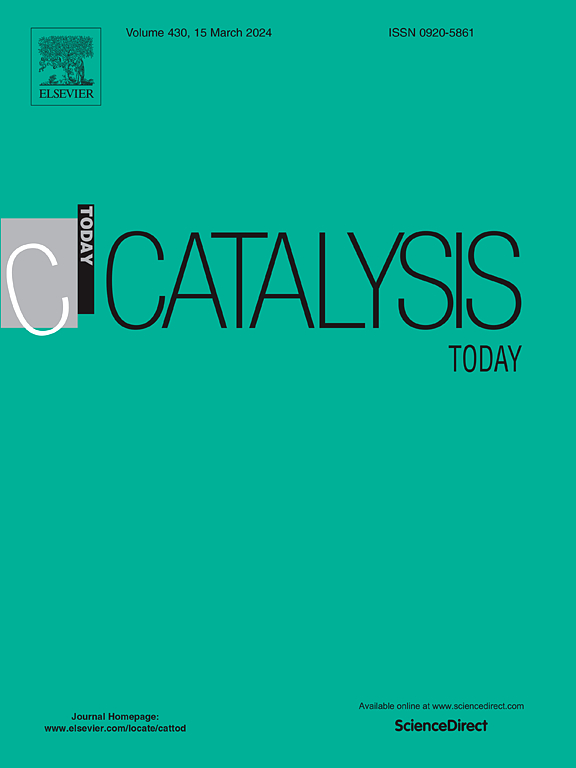影响低维氧化锌纳米结构光催化和光电化学性能的结构因素
IF 5.2
2区 化学
Q1 CHEMISTRY, APPLIED
引用次数: 0
摘要
本研究在 FTO 玻璃基底上连续合成了三种复杂程度的低维 ZnO 纳米结构(一级多晶、二级纳米线和三级纳米枝晶),并探讨了其结构和形态对光催化和光电化学(PEC)性能的影响。X射线衍射、扫描电镜和拉曼光谱以及聚光和紫外-可见光测量结果表明,纳米晶的钨锆石构筑块具有形状各向异性,缺陷浓度随着复杂程度的增加而增加。将四种雌激素,即雌酮(E1)、雌二醇(E2)、炔雌醇(EE2)和雌三醇(E3)作为内分泌干扰物模型进行评估,以评估每种激素的相对光降解情况。在 AM 1.5 G 光照下,这些材料作为光阳极的 PEC 分水性能也呈现出相同的趋势。相反,以双氯芬酸为模型药物的光降解性能和利马嗪油墨褪色测试表明,多晶样品的性能更优,纳米树枝状晶样品次之。这些还原性光催化途径过程可能是由溶液/催化剂边界的界面电荷转移效率决定的,而其他因素可能与氧化锌的还原电位相对较弱而氧化电位相对较大有关。本文章由计算机程序翻译,如有差异,请以英文原文为准。
Structural factors influencing photocatalytic and photoelectrochemical performance of low-dimensional ZnO nanostructures
In this study, low dimensional ZnO nanostructures at three levels of complexity (primary polycrystalline, secondary nanowires, and tertiary nanodendrites) were consecutively synthesized on FTO glass substrates, and the impact of their structure and morphology on photocatalysis and photoelectrochemical (PEC) properties was explored. XRD, SEM, and Raman corroborated with PL and UV–vis measurements revealed nanocrystallite wurtzite building blocks with shape anisotropy and defect concentration increasing with the level of complexity. Four estrogenic hormones, i.e., estrone (E1), estradiol (E2), ethinylestradiol (EE2), and estriol (E3), were evaluated as model endocrine disruptors to assess the relative photodegradation of each hormone. The same trend was observed for PEC water-splitting performance of these materials as photoanodes under AM 1.5 G illumination. On the contrary, the performance on photodegradation of diclofenac as a model drug and resazurin ink discoloration test revealed superiority of the polycrystalline sample followed by the nanodendrites sample. These reductive photocatalytic pathway processes are likely to be governed by the interfacial charge transfer efficiency at the solution/catalyst boundary, while the other factors may have more intriguing roles associated with the relatively weak reduction potential of ZnO in comparison to its large oxidation potential with respect to water splitting.
求助全文
通过发布文献求助,成功后即可免费获取论文全文。
去求助
来源期刊

Catalysis Today
化学-工程:化工
CiteScore
11.50
自引率
3.80%
发文量
573
审稿时长
2.9 months
期刊介绍:
Catalysis Today focuses on the rapid publication of original invited papers devoted to currently important topics in catalysis and related subjects. The journal only publishes special issues (Proposing a Catalysis Today Special Issue), each of which is supervised by Guest Editors who recruit individual papers and oversee the peer review process. Catalysis Today offers researchers in the field of catalysis in-depth overviews of topical issues.
Both fundamental and applied aspects of catalysis are covered. Subjects such as catalysis of immobilized organometallic and biocatalytic systems are welcome. Subjects related to catalysis such as experimental techniques, adsorption, process technology, synthesis, in situ characterization, computational, theoretical modeling, imaging and others are included if there is a clear relationship to catalysis.
 求助内容:
求助内容: 应助结果提醒方式:
应助结果提醒方式:


